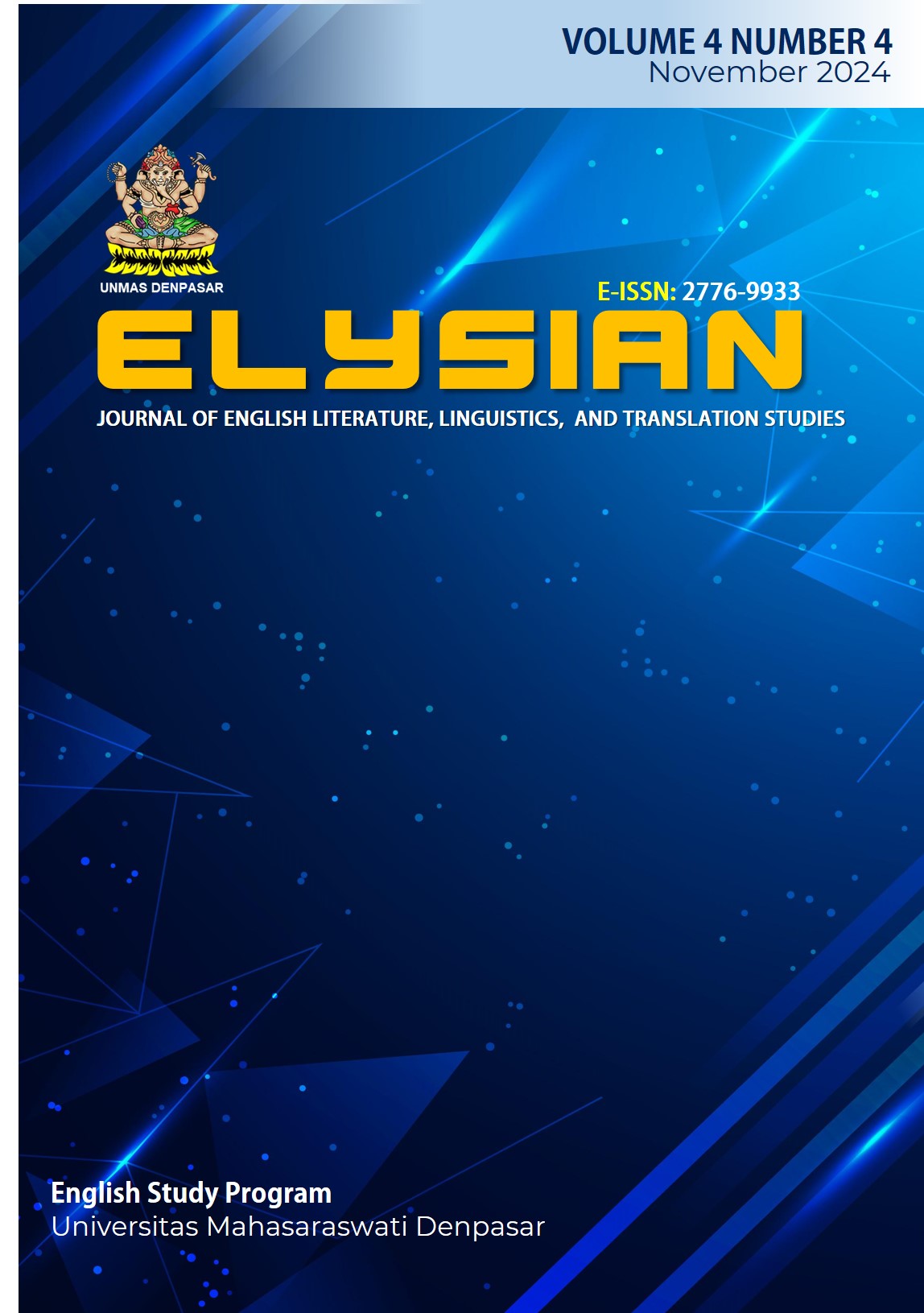Representatives Illocutionary Act Found in Wednesday Addams Movie
DOI:
https://doi.org/10.36733/elysian.v4i4.9779Abstract
This study explores representative speech acts in the Wednesday Addams movie, analyzing their frequency, types, and functions. The primary goal of the research is to analyze how representative speech acts are used in character dialogue to conve beliefs, intentions, personalities, and to understand their contribution to narrative and character development. Employing Yule's (1996) classification and Leech's (1983) theory, the study identifies 25 instances of representative speech acts categorized into statements of fact, assertions, conclusions, and descriptions. Statements of fact were found to be the most frequent (32%), followed by descriptions (28%), assertions (20%), and conclusions (20%). These representative speech acts provide significant insights into the characters’ beliefs, intentions, and personalities, contributing to the narrative and character development of the film. The study also compares findings with previous research, indicating that while prior studies have focused on broader speech acts, this research narrows its focus to representative speech acts, offering a more detailed understanding of their role in character dialogue and storytelling. A qualitative descriptive method was applied by analyzing the dialogue in the Wednesday Addams script. This study explores how language is used in movies, especially in modern movie.
References
Abdullah, A. F., Nurwahyuni, K., & Lantemona, O. S. (2020). Illocutionary Act in Ice Age Collision Course Movie Script. International Journal of Systemic Functional Linguistics, 3(2), 72-80.
Barsam, R. and Dave Monahan. 2009. Looking at movies and Introduction to film. New York: W.W. Norton & Company, Inc
Busetto, L., Wick, W., & Gumbinger, C. (2020). How to use and assess qualitative research methods. Neurological Research and practice, 2 (1), 14.
Candra, K. D. P., Simpen, I. W., Sudipa, I. N., & Artawa, K. (2019). Study of Illocutionary Acts in Balinese Humor. Journal of Bali Studies, 3(2), 78-90.
Chimayasari, F. (2016). A pragmatic analysis of illocutionary acts performed by the main character in Alan Poul’s the Back Up-Plan movie. (Master’s thesis). Yogyakarta State University, Yogyakarta.
Doe, J., Smith, L., & Brown, M. (2021). The Role of Illocutionary Acts in Political Debates: A Case Study on Assertive and Commissive Speech Acts. International Journal of Communication and Politics, 15(3), 132-150.
J. L. Austin, How to Do Things with Words (Oxford: Clarendon Press, 1962)
Leech, G. (1983). Principles of Pragmatics. London: Longman.
Levinson, S.C. 1983. Pragmatics. Great Britain: Cambridge University Press.
Purba, R. and Herman. (2020). Multimodal Analysis on Ertiga Car Advertisement. Wiralodra English Journal (WEJ), Vol 4 No 1 Maret 2020, PP. 21-32. Retrieved from http://wej.unwir.ac.id/index.php/wej/article/view/77
Searle, J. R. (1969). Speech acts: An essay in the philosophy of language. Cambridge University Press.
Smith, A., & Brown, E. (2018). Directive and Expressive Speech Acts in Classroom Communication: Analyzing Teacher-Student Interactions. Journal of Educational Linguistics, 6(4), 98-114.
Supriyadi, S. (2020). Pragmatic Analysis on G.M. Sudarta’s Caricatures in Kompas
Suryanti, S. (2020). An analysis of representative speech acts in" The Daily Talk Show. Pragmatics Approach.
Yule, G. (1996). Pragmatics. Oxford: Oxford University Press.








